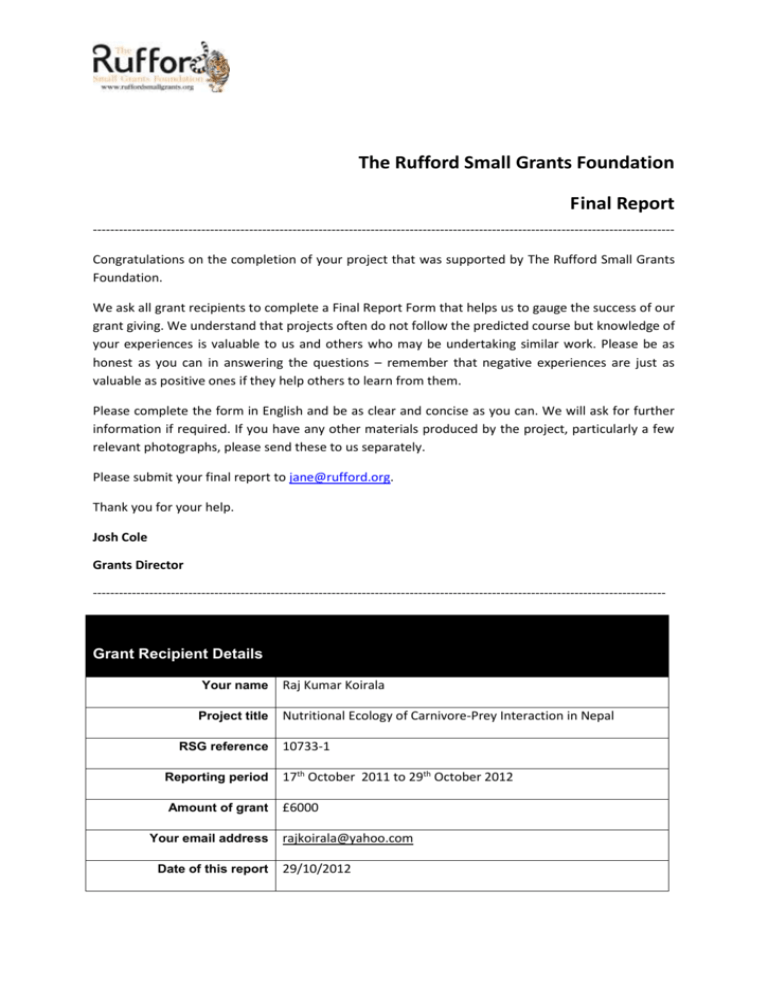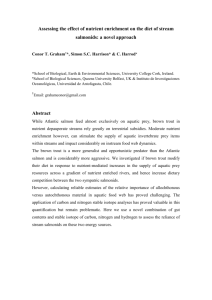Final Report - Rufford Foundation
advertisement

The Rufford Small Grants Foundation Final Report -------------------------------------------------------------------------------------------------------------------------------------Congratulations on the completion of your project that was supported by The Rufford Small Grants Foundation. We ask all grant recipients to complete a Final Report Form that helps us to gauge the success of our grant giving. We understand that projects often do not follow the predicted course but knowledge of your experiences is valuable to us and others who may be undertaking similar work. Please be as honest as you can in answering the questions – remember that negative experiences are just as valuable as positive ones if they help others to learn from them. Please complete the form in English and be as clear and concise as you can. We will ask for further information if required. If you have any other materials produced by the project, particularly a few relevant photographs, please send these to us separately. Please submit your final report to jane@rufford.org. Thank you for your help. Josh Cole Grants Director ------------------------------------------------------------------------------------------------------------------------------------ Grant Recipient Details Your name Raj Kumar Koirala Project title Nutritional Ecology of Carnivore-Prey Interaction in Nepal RSG reference 10733-1 Reporting period 17th October 2011 to 29th October 2012 Amount of grant £6000 Your email address Date of this report rajkoirala@yahoo.com 29/10/2012 1. Please indicate the level of achievement of the project’s original objectives and include any relevant comments on factors affecting this. Fully achieved Partially achieved Not achieved Objective To identify the principal prey species of tigers and leopards, and to know the proportions of each in the diet using microanalysis of scat, √ To identify the plant foods of the principal prey of tiger and leopard and the proportions of each in the diet through combining of direct observations of feeding with micro histological analysis of faces, √ To analyse the representative samples of each food for their macro and micro nutrient composition. To perform geometrical modelling to establish a multi-dimensional overview of how the distributions of plant nutrients influence the habitat use of tiger/ leopard prey and, √ √ Comments The scats were collected adjacent to tiger and leopard signs scrapes and scent sprays or claw marks. The scats were identified on the basis of sizes, general appearances, associated signs and pugmarks. Scat samples were prepared according to the methods described by Mukherjee et al. (1994). Prey species in the scats were identified by comparison with a reference collection of slides and photographs of the structure of the cuticle and medulla of hair of potential prey species. Micro faecal (Pellet) Analysis is based on micro histological analysis a method that followed mainly Sparks and Malechek (1968) and Anthony and Smith (1974). Identified the indigestible plant fragments, mainly the epidermal features that are characteristic of different plant groups (Metcalfe 1990). All sample materials were boiled in sodium hydroxide and in distilled water. Slides were prepared using the procedure of Sparks and Malechek (1968). The accuracy of identifying the plant fragments was the overall limitation. Fragmentation may differ between species during digestion so the relative proportions of species appear different. Direct observation was quite inappropriate and difficulty in sighting especially the shy species like sambar and hog deer. Plant foods were analysed for their macro and micro nutrient composition. Although our anticipation was to develop ability to model geometrically the relationship between compositions of foods eaten and nutrient intakes across several days. Sufficient replication to match the patterns of nutrient intake to established models of different patterns of nutrient prioritisation. However, due to shy nature of these herbivores and low detection rate, direct food intake measurement ultimately, of the tiger/ leopard themselves. could not be performed. I had to rely on indirect method through pellet analysis to calculate the proportion of different plant foods in their diet. I couldn’t sufficiently replicate to geometrically analyse the compositional relationships between diet and matched faeces and establish the uptake efficiencies of different nutrients, and how these change with variation in intake (i.e. post-ingestive homeostatic regulation) I hope to accomplish the above constraints with a refined food intake measurement technique for wild herbivores to be developed in subsequent project mainly focussing on wild Asian elephant. 2. Please explain any unforeseen difficulties that arose during the project and how these were tackled (if relevant). None. 3. Briefly describe the three most important outcomes of your project. We have found the principal prey species of tigers and leopards through the scats collected from the study area. Primary food plants of the herbivores were identified through micro histological analysis. The result has enhanced to understand the general feeding ecology of tiger /leopard and their prey species. 4. Briefly describe the involvement of local communities and how they have benefitted from the project (if relevant). None. 5. Are there any plans to continue this work? I am a PhD student and my PhD topic is “Nutritional ecology of domestic and wild Asian elephants in Nepal”. I will continue the same nature of work focussing towards large herbivore, the Asian elephant. The proposed research on captive, domestic and wild Asian elephant will provide an opportunity to perform detailed measurements of the patterns of nutrient intake (from feeding observations and nutritional measurements of the foods) and nutrient utilisation (from comparisons of diet and dung compositions). It will also provide an opportunity in a controlled, captive situation to validate some of the key methods being applied in my studies of the domesticated herd, which in turn is being used to validate measures used for the wild population. Finally, the study will enable me to make a direct comparison between the nutrient content and patterns of nutrient regulation in the diets of the wild and domesticated elephants in Nepal .The comparison of nutrient content will help to inform elephant husbandry practices in zoos, and the pattern of nutrient regulation. The primary aims are: i. to compare the nutritional content; ii. patterns of macronutrient regulation in the diets of free-ranging wild elephants with the partially managed diets of a domesticated group derived from the wild population; and iii. to compare the nutritional composition of agricultural crops that are raided by elephants to construct a predictive model of the circumstances under which crop raiding by elephants in Nepal takes place. 6. How do you plan to share the results of your work with others? I am working on the paper to be published in the international journal. 7. Timescale: Over what period was the RSG used? How does this compare to the anticipated or actual length of the project? The RSG was used over the period of 12 months. Although the anticipated time frame was 14 months. The difference is not much. 8. Budget: Please provide a breakdown of budgeted versus actual expenditure and the reasons for any differences. All figures should be in £ sterling, indicating the local exchange rate used. Item Total budget amount fulfilled the required expenses with slight adjustment to accommodate nutritional analysis lab expenses which is more than the budgeted. Total Budgeted Amount £6000 Actual Amount £ 6150 £6000 £6150 Difference Comments £150 The difference was due to a bit higher amount for nutritional analysis. *1 Pound sterling = 137 NPR 9. Looking ahead, what do you feel are the important next steps? The important next steps will be: (1) To publish the results in peer-reviewed journals. (2) To refine the technique for quantification of wild herbivore intake of food plants to be able to model the food choice and nutritional priorities of these herbivores including Asian elephant. 10. Did you use the RSGF logo in any materials produced in relation to this project? Did the RSGF receive any publicity during the course of your work? No, I haven’t used the logo yet. However I will be using it in my forthcoming publication. For publicity, I acknowledged the RSGF grant in the following publication. Koirala, R., A. Aryal, C. Amiot, B. Adhikari, D. Karmacharya, and D. Raubenheimer. 2012. Genetic identification of carnivore scat: implication of dietary information for human-carnivore conflict in the Annapurna Conservation Area, Nepal: Zoology and Ecology, doi=10.1080/21658005.2012.744864. (In press) 11. Any other comments? I wish to extend my deep thanks to the Rufford Small Grants for Nature Conservation, for the financial support which made possible for this project to achieve its fruitful goals.





